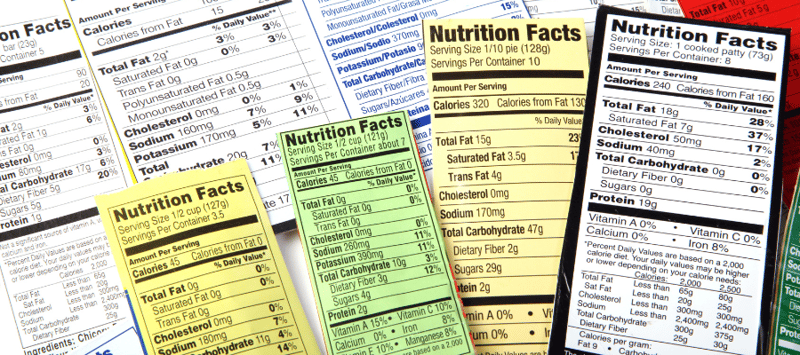
Ever stared at a food label and thought it looked like a secret code? You're not alone!Many of us find food labels confusing and, dare we say, a little sneaky. But don't worry, this article is your decoder ring. We're going to unlock the mysteries of the most puzzling food label claims, from 'Natural' to 'Gluten-Free', and everything in between.
That's why we're here to play detective with you. At OnPoint Nutrition, we’ve guided over 3,000 individuals, one-on-one, to get the down-low on their meals.
This will not only help you understand what you're putting in your shopping cart, but also what you're putting in your body. Armed with this knowledge, you'll be able to make healthier and smarter food choices.
Now, let's uncover what those tricky food labels really mean.
Understanding Food Labeling Basics and Standards
Now, here's a surprising fact. Even though food labels should be our go-to guides on what's in our food, sometimes, they're as confusing and deceptive as they come.And that's not your fault!
Food labels are under rules set by important guys like the FDA and USDA. But these rules can let some confusing terms slip through the net. Additionally, there are often not precise and stringent policy on clarity -- leaving you believing that things are true to label, when they may not be.So, we're going to break it all down for you.
Decoding Most Misunderstood Food Label Claims
Let's dive into the nitty-gritty and take a look at some of the most perplexing label claims.
We'll unravel the mysteries behind some of the most perplexing labels, from the elusive "Natural" claim to the sometimes misleading "Organic" and "Free Range" labels. Get ready to decode the jargon and gain a deeper understanding of what these labels truly mean for your health and food choices.
By demystifying these label claims, we can empower ourselves to make informed decisions about the food we consume, ensuring that our choices align with our health goals and values.
Demystifying 'Natural' Food Label Claims
The term "Natural" sounds simple, right? Well, not so fast! This word can be a bit of a wild card. It doesn't have a fixed definition, which can make things sticky when you're trying to pick the healthiest food.
The FDA doesn't have an official definition for the term "Natural" when it comes to food labeling. As a result, food companies have some leeway in using this label. You might find products labeled as "all-natural," "100% natural," or simply "natural." But what does it really mean?
In practice, the term "Natural" is often interpreted as meaning that a product doesn't contain artificial flavors, colors, or synthetic additives. However, this doesn't guarantee that the food is minimally processed or free from other questionable ingredients. Some foods labeled as "Natural" can still contain high amounts of added sugars, sodium, or unhealthy fats.
The lack of a clear definition and standardized criteria for using the "Natural" label can lead to confusion and misleading marketing.
It's important to read beyond the front label and check the ingredients list and nutrition facts panel to get a complete understanding of what you're really consuming.
To make more informed choices, focus on whole, unprocessed foods like fruits, vegetables, whole grains, and lean proteins.
These foods are naturally nutritious and don't require a label to tell you they're natural.
Breaking Down the 'Organic' Label Misconceptions
Then, there's "Organic." It means the food has passed certain checks. But not all checks are created equal, and sometimes, foods that seem organic might not be as earth-friendly as they appear.
When a product is labeled as "Organic," it means that it has been produced following specific guidelines and regulations that prohibit the use of synthetic pesticides, genetically modified organisms (GMOs), and certain fertilizers. It's a step toward more sustainable agriculture practices.
However, here's where it gets a little tricky. Organic certification can vary depending on the country or certifying body. Some organic standards may be more stringent than others, while some certifications might not encompass the full range of environmentally friendly practices.
Additionally, organic farming methods may still have some environmental impacts, such as land use and transportation. Plus, organic doesn't automatically mean healthier or more nutritious. Organic junk food is still junk food.
It's also worth noting that organic products often come with a higher price tag due to the additional costs associated with organic farming practices and certification.
So, while choosing organic can align with your values and support more sustainable practices in agriculture, it's essential to look beyond the label and consider other factors like local and seasonal produce, supporting small farmers, and overall dietary balance.
Ultimately, being an informed consumer means delving deeper into the details and understanding the bigger picture when it comes to organic labeling.
'Free Range' and 'Cage Free': More Than Meets the Eye
"Free Range" and "Cage Free" sound pretty outdoorsy and free-spirited, huh? Unfortunately, the reality might not be as sunny as we'd like to think. These labels can be a bit foggy when it comes to the actual living conditions of the animals.
"Free Range," for example, means that poultry has been allowed access to the outside. But the term doesn't specify the quality or size of the outdoor space, or how much time each day the birds actually spend outside.
Similarly, "Cage Free" means that the birds aren't kept in cages, but it doesn't necessarily mean they have ample space or access to outdoors. They could be in crowded barns with limited room to move around.
Furthermore, these labels don't indicate anything about the animal's diet or whether antibiotics were used, both of which can significantly impact the nutritional quality of the resulting meat or eggs.
It's also worth noting that these labels often come with a higher price tag, but the actual benefits in terms of animal welfare and nutritional value might not be as substantial as we'd hope.
To make more informed choices, consider looking for additional labels that provide more details about animal welfare, such as "Certified Humane" or "Animal Welfare Approved". And, as always, a balanced diet rich in plant-based foods can be a great complement to any animal products you choose to consume.
The 'Non-GMO' Label: What You Need to Know
Next up is "Non-GMO." This term is all about whether a food's been genetically tinkered with or not. You'll see it on lots of products, from cereals to chips, and it might seem like a pretty clear green flag. But just because something is Non-GMO doesn't always mean it's the healthier option. Go figure!
GMO stands for Genetically Modified Organism. These are plants or animals that have been genetically altered in ways that do not occur naturally, usually to make them resistant to pests, diseases, or harsh environmental conditions.
However, being Non-GMO doesn't automatically elevate a food product to super-healthy status. Why? Well, a product can be Non-GMO and still be packed with unhealthy amounts of sugar, fat, or sodium. For instance, a bag of Non-GMO chips might not contain any genetically modified ingredients, but it can still be high in fat and salt, and therefore not a healthy choice.
Similarly, a sugary cereal might boast a Non-GMO label, but it can still lead to a sugar crash that leaves you feeling sluggish a couple of hours later.
So, while choosing Non-GMO might align with your values for environmental or ethical reasons, it's not a surefire indicator of a product's overall nutritional quality.
The best course of action is to check the whole label, especially the ingredients list and nutrition facts, to get a comprehensive view of whether a food aligns with your healthy eating goals.
The Truth Behind the 'Zero Trans Fat' Claim
"Zero Trans Fat" sounds like a big fat zero problem, but here's the twist.
Sometimes, zero doesn't mean none at all. A food can still have a smidge of trans fats and wear this label. Talk about a sneaky move!
Here's the lowdown: in the world of food labeling, 'zero' doesn't always mean absolute zero. According to FDA regulations, if a food contains less than 0.5 grams of trans fat per serving, the food company can label the product as having "Zero Trans Fat." So, if you're eating multiple servings, those "insignificant" amounts of trans fat can add up quickly.
Trans fats are a "regular consumption" no-no for our health. They are associated with increased bad cholesterol levels, decreased good cholesterol levels, and a higher risk of developing heart disease and stroke. They're even linked to a higher risk of developing type 2 diabetes.
So, a food labeled as "Zero Trans Fat" might still be harming your health if you're not mindful of your intake. One way to double-check is to look at the ingredients list. If you see "partially hydrogenated oils," that's a sign that the product might contain hidden trans fats.
The key takeaway here? Don't be fooled by the zeros. Go that extra mile to check the ingredients and serving size, because when it comes to your health, every little bit counts!
'Gluten-Free': A Misused Label?
Lastly, "Gluten-Free" is a term you've probably seen everywhere. But unless you're one of the people who need to dodge gluten for health reasons, this label doesn't automatically mean healthier.
Now, gluten is a type of protein found in grains like wheat, barley, and rye. For certain individuals, such as those with celiac disease or non-celiac gluten sensitivity, consuming gluten can lead to harmful health effects. So, a gluten-free label is absolutely crucial for them.
However, for the majority of folks, going gluten-free doesn't offer any special health benefits.
In fact, gluten-free products can sometimes contain more sugars or fats to compensate for texture and taste, potentially leading to unnecessary calorie consumption. Plus, they often come with a heftier price tag too.
Also, bear in mind that many naturally gluten-free foods like fruits, vegetables, lean meats, and certain grains are healthier and more nutrient-dense than processed gluten-free products. So, while the 'gluten-free' label is vital for some, for others it may just be a marketing ploy. The key is understanding your individual dietary needs and making informed decisions.
How Confusing Labels Impact Consumer Choices
These puzzling labels can turn a quick grocery trip into a head-scratching mystery. They can also impact the choices we make, our health, and even our wallets. Imagine paying extra for something you thought was healthier but wasn't. Bummer, right?
But the effects extend beyond just your pocketbook. Misunderstanding labels can also impact your health goals, sometimes significantly. For instance, falling for the 'natural' trap might lead you to consume more sugars or fats than you intended. Or, being swayed by a 'zero trans fat' label may result in unknowingly eating harmful fats, which could lead to heart health issues over time.
Not only that, but these confusing labels can also derail diet plans. For those managing diabetes or trying to lose weight, misconstrued labels can lead to consuming foods higher in carbs or calories than they realized, stalling progress and causing frustration.
Indeed, the impact of these confusing food labels goes beyond mere inconvenience. They can create real roadblocks in our path to health and wellness. That's why gaining label literacy is such an essential step in taking control of our diets and, ultimately, our health.
Expert Tips for Understanding Tricky Food Labels
Enough of the confusing stuff.
Let's talk about how to crack the food label code. The key is to know what those tricky terms mean and how to read the nutrition facts like a pro. And remember, fresh is best.
When in doubt, go for foods that don't need a label - fruits, veggies, lean meats, and whole grains are always winners!
Wrapping Up: The Importance of Food Label Literacy
Food labels might seem like they're written in a different language, but they don't have to be a stumbling block. The trick is to know what to look for and what to take with a grain of salt.
At OnPoint Nutrition, we're all about helping you make healthy, sustainable choices. Our one-on-one coaching approach is tailor-made for challenges just like this. You see, everyone's dietary needs and health goals are unique.
Whether you're aiming for weight loss, managing a chronic disease, or just wanting to feel healthier, understanding food labels is a vital part of the journey.
Having a personal coach can make a huge difference. They're like a compass guiding you through the tricky terrain of food label claims, debunking myths, and providing clarity. More than that, they're your cheerleader, supporting you as you build a healthier relationship with food.
We've had the pleasure of empowering more than 3,000 individuals with the knowledge to navigate the grocery store aisles with confidence. So, next time you're faced with a tricky food label, remember you don't have to do it alone. With a little help, you can turn these challenges into victories on your path to better health.
Happy decoding!
Topics

With a knack for turning complex nutrition facts into engaging, relatable content, she’s on a mission to make healthy living fun and accessible. Backed by a stellar team of Dietitians and Nutritionists, Abby breathes life into OnPoint’s mission, inspiring others to embrace the transformative power of good nutrition. Her infectious enthusiasm and innovative approach make her a driving force in the journey towards better health for all.



